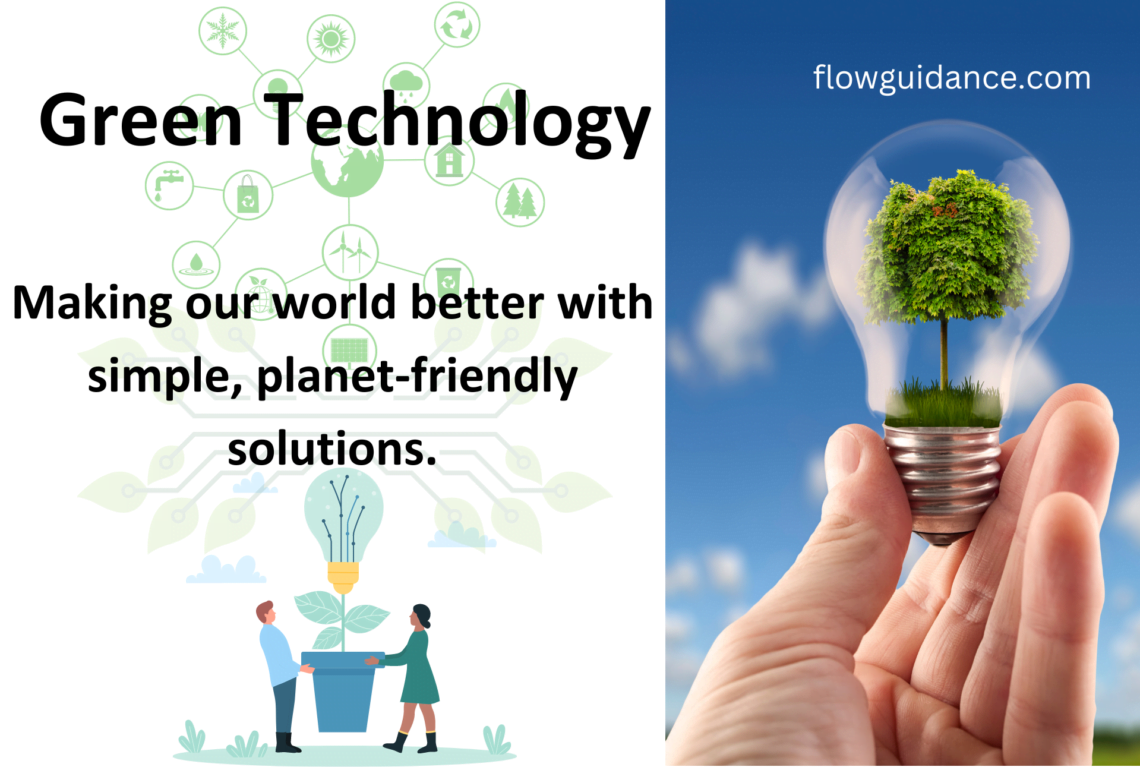Introduction:
Define Green Technology:
Green technology, also known as eco-friendly or sustainable technology, refers to innovations designed to minimize their environmental impact. These technologies aim to address pressing environmental challenges such as climate change, resource depletion, and pollution. The significance of green technology lies in its potential to pave the way for a more sustainable and ecologically balanced future.
Historical Perspective:
Trace the evolution of green technology:
The roots of green technology can be traced back to the 19th century with the advent of early environmental movements. However, the modern green technology era began in the late 20th century, marked by breakthroughs in renewable energy and environmental awareness. Milestones include the development of the first solar cell and the establishment of the Environmental Protection Agency (EPA) in the 1970s.
Types of Green Technology:
Renewable Energy:
Renewable energy sources, such as solar power, wind energy, and hydropower, harness naturally replenishing resources to generate electricity. Solar panels convert sunlight into electricity, wind turbines capture wind energy, and hydropower utilizes the energy of flowing water, providing clean alternatives to traditional fossil fuels.
Energy Efficiency:
Technologies improving energy efficiency play a crucial role in reducing overall energy consumption. Advances in building materials, smart grids, and energy-efficient appliances contribute to minimizing energy waste in residential, commercial, and industrial settings.
Waste Management:
Green technology in waste management involves innovative methods for recycling, reducing, and reusing materials. Technologies like composting, waste-to-energy conversion, and advanced recycling systems contribute to minimizing the environmental impact of waste.
Sustainable Agriculture:
Green technology in waste management involves innovative methods for recycling, redaIn agriculture, green technology emphasizes sustainable practices such as precision farming, agroforestry, and organic farming. These approaches prioritize environmental conservation, reducing the use of harmful chemicals and promoting soil health.ucing, and reusing materials. Technologies like composting, waste-to-energy conversion, and advanced recycling systems contribute to minimizing the environmental impact of waste.
Clean Transportation:
Green transportation solutions, including electric vehicles (EVs) and public transportation systems, aim to reduce the carbon footprint associated with traditional modes of transportation. EVs, for instance, utilize clean energy sources and emit fewer greenhouse gases than traditional vehicles.
Examples and Case Studies:
Google's 100% Renewable Energy Commitment:
Google, a technology giant, has made a substantial commitment to sustainability by pledging to power its operations with 100% renewable energy. This involves a significant investment in solar and wind energy projects. The company’s data centers and offices worldwide are increasingly powered by clean energy sources, reducing its carbon footprint and setting an example for other large corporations.
Tesla's Electric Vehicle Advancements:
Tesla, led by entrepreneur Elon Musk, has revolutionized the automotive industry with its electric vehicles (EVs). Tesla’s commitment to green technology is evident in its production of high-performance electric cars that have gained popularity globally. With innovations like the Model S, Model 3, and Model X, Tesla has demonstrated the feasibility and desirability of electric vehicles, accelerating the shift towards sustainable transportation.
Freiburg, Germany - Sustainable Urban Development:
The city of Freiburg in Germany stands as a model for sustainable urban development. Embracing green technology, Freiburg has implemented initiatives such as energy-efficient buildings, extensive green spaces, and an advanced public transportation system. The city’s commitment to renewable energy, including solar-powered neighborhoods, has not only reduced its environmental impact but also enhanced the overall quality of life for its residents.
Masdar City, UAE - A Sustainable Urban Oasis:
Masdar City in the United Arab Emirates is a groundbreaking example of sustainable urban planning. Designed with a focus on renewable energy and eco-friendly architecture, Masdar City aims to be carbon-neutral. The city utilizes solar power extensively, employs water-saving technologies, and promotes sustainable transportation. Masdar City serves as a living laboratory for green technology applications in urban environments.
IKEA's Sustainable Practices:
IKEA, a global furniture retailer, has committed to integrating green technology into its operations. With a focus on renewable energy, energy-efficient lighting, and sustainable sourcing of materials, IKEA aims to be a climate-positive company. The installation of solar panels on store rooftops, along with initiatives to reduce waste and promote recycling, showcases a comprehensive approach to sustainability in the retail sector.
Costa Rica's Renewable Energy Achievement:
Costa Rica has made significant strides in green technology by relying on renewable energy sources to meet a substantial portion of its electricity demand. The country has set records for running on 100% renewable energy for extended periods. Its commitment to hydropower, wind, and geothermal energy has not only reduced carbon emissions but also positioned Costa Rica as a global leader in sustainable energy practices.
Environmental Benefits:
Reducing Carbon Emissions: Green technology plays a pivotal role in mitigating climate change by significantly reducing carbon emissions. Renewable energy sources such as solar, wind, and hydropower generate electricity without emitting greenhouse gases, offering a cleaner alternative to traditional fossil fuels. The adoption of electric vehicles, a component of green transportation, further reduces carbon emissions associated with conventional automobiles, contributing to cleaner air and a healthier environment.
Conserving Resources: One of the fundamental principles of green technology is resource conservation. Technologies focused on energy efficiency, sustainable agriculture, and waste reduction help minimize resource consumption. Energy-efficient appliances and buildings, for example, require less power, reducing the demand for fossil fuels and lessening the environmental impact of resource extraction. Sustainable agricultural practices prioritize responsible land and water use, contributing to the long-term health of ecosystems.
Promoting Biodiversity: Green technology aids in preserving biodiversity, the variety of life on Earth, by mitigating the negative impacts of human activities on ecosystems. Sustainable agricultural practices, such as agroforestry and organic farming, prioritize biodiversity by avoiding the extensive use of harmful pesticides and promoting natural habitats for diverse plant and animal species. Additionally, green initiatives often include measures to protect and restore ecosystems, ensuring a balance that supports a variety of life forms.
Mitigating Air and Water Pollution: The adoption of green technologies helps mitigate air and water pollution, safeguarding the quality of essential resources. The reduction of emissions from fossil fuels, particularly in industries and transportation, contributes to cleaner air. Advanced waste management technologies, including recycling and waste-to-energy processes, prevent harmful pollutants from entering landfills and water bodies, preserving the integrity of ecosystems and benefiting both human and environmental health.
Limiting Deforestation and Land Degradation: Green technology practices aim to limit deforestation and land degradation, protecting vital ecosystems. Sustainable forestry practices, coupled with the use of alternative materials and recycled products, contribute to the conservation of forests. This approach helps maintain biodiversity, prevents soil erosion, and ensures the long-term viability of ecosystems that support diverse plant and animal life.
Enhancing Climate Resilience: Green technology contributes to enhancing climate resilience by promoting adaptive strategies and technologies. Sustainable land-use practices, resilient infrastructure, and innovations in water management help communities better withstand the impacts of climate change, such as extreme weather events and rising sea levels. These initiatives contribute to the overall environmental sustainability of regions and support the well-being of both natural and human ecosystems.
Challenges and Solutions:
High Initial Costs:
- Challenge: Implementing green technology often involves higher upfront costs compared to conventional, less environmentally friendly alternatives. This financial barrier can be a significant challenge for businesses and individuals looking to adopt sustainable practices.
- Solution: Government incentives, subsidies, and tax credits can play a crucial role in offsetting initial costs. As technology advances and economies of scale come into play, the costs of green solutions are expected to decrease, making them more accessible to a broader audience.
Intermittency Issues with Renewable Energy:
- Challenge: Renewable energy sources, such as solar and wind power, are subject to intermittency due to weather conditions. This variability in energy production poses challenges for maintaining a consistent and reliable power supply.
- Solution: Advances in energy storage technologies, such as large-scale batteries, offer a solution to the intermittency challenge. Energy storage allows excess energy generated during peak times to be stored and used during periods of low energy production, ensuring a continuous and reliable power supply.
Limited Infrastructure and Accessibility:
- Challenge: In some regions, the infrastructure required to support green technology may be limited, hindering the widespread adoption of sustainable practices. Additionally, accessibility to certain green solutions may be a challenge for communities in remote or economically disadvantaged areas.
- Solution: Increased investment in green infrastructure, including the development of renewable energy grids and charging stations for electric vehicles, can address these challenges. Government initiatives and private-sector partnerships can play a role in expanding green technology accessibility to underserved communities.
Technological Innovation and Research:
- Challenge: The rapid pace of technological advancement in the green technology sector requires ongoing research and development. Keeping up with the latest innovations can be a challenge for businesses and industries seeking to adopt the most efficient and sustainable solutions.
- Solution: Continued investment in research and development is essential. Collaboration between government, private sector, and academic institutions can drive innovation. Knowledge-sharing platforms and partnerships can facilitate the dissemination of the latest advancements across industries.
Public Awareness and Education:
- Challenge: Limited public awareness and understanding of green technology and its benefits can impede widespread adoption. Education is crucial to overcome resistance and skepticism about the feasibility and effectiveness of sustainable practices.
- Solution: Educational campaigns, community outreach programs, and school curricula that emphasize the importance and advantages of green technology can raise awareness. Informing the public about the environmental and economic benefits encourages informed decision-making at both individual and community levels.
Policy and Regulatory Frameworks:
- Challenge: Inconsistent or inadequate policies and regulations can create uncertainty for businesses and investors in the green technology sector. Clear and supportive regulatory frameworks are essential for fostering a conducive environment for sustainable practices.
- Solution: Governments play a vital role in creating stable regulatory environments that incentivize the adoption of green technology. Comprehensive policies, tax incentives, and standards that promote sustainability provide a foundation for businesses to invest confidently in environmentally friendly solutions.
Government Policies and Incentives:
Government policies and incentives play a pivotal role in promoting the adoption of green technology. Subsidies for renewable energy projects, tax credits for eco-friendly practices, and stringent environmental regulations collectively shape the landscape of the green tech industry, fostering its growth.
Future Trends:
The future of green technology holds exciting possibilities, with emerging technologies like advanced energy storage, sustainable materials, and artificial intelligence for environmental monitoring. These innovations have the potential to revolutionize sustainability practices across various industries.
Advantages for Businesses:
Adopting green technology provides businesses with economic benefits, including cost savings through energy efficiency, enhanced corporate social responsibility, and a competitive edge in a market increasingly focused on sustainability.
Green Technology and Global Initiatives:
International collaborations and agreements, exemplified by the Paris Agreement, stand as pivotal milestones in the global commitment to combating environmental challenges through green technology. The Paris Agreement, adopted in 2015, unites countries worldwide in a shared commitment to limit global warming and reduce greenhouse gas emissions. This accord not only acknowledges the urgency of addressing climate change but also emphasizes the role of innovative green technologies in achieving these goals. The agreement fosters a collaborative framework that encourages knowledge sharing, technology transfer, and collective efforts among nations. Through such global initiatives, countries can leverage the collective wisdom and experiences of others, accelerating the adoption and implementation of sustainable practices. Additionally, these collaborations provide a platform for joint research and development, enabling the creation of cutting-edge green technologies that can be shared globally. By fostering a sense of shared responsibility, international initiatives contribute to shaping a more interconnected and sustainable future, transcending geographical boundaries for the benefit of the planet as a whole.
Conclusion:
In conclusion, green technology is a powerful force driving positive change in how we approach technology and its impact on the environment. Embracing these innovations is crucial for building a sustainable future that balances economic growth with environmental stewardship.
For further exploration and insights, feel free to visit flow guidance.
Call to Action:
As individuals and organizations, we can contribute to a greener future by adopting eco-friendly practices. Whether through energy-efficient choices, sustainable transportation, or waste reduction, small actions collectively make a significant impact. Explore further resources and get involved in initiatives that align with green technology principles to be part of the solution for a more sustainable planet.





